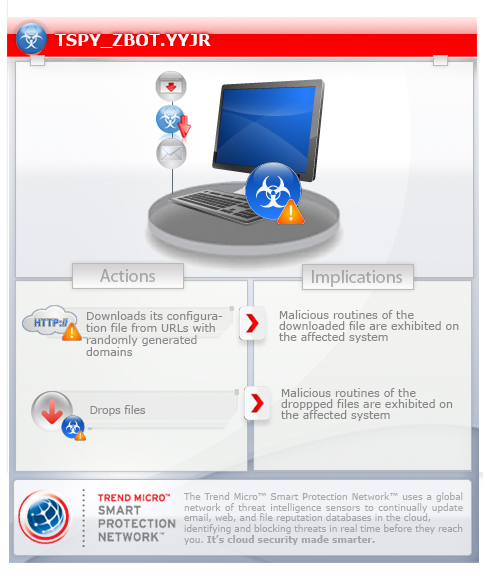TSPY_ZBOT.YYJR
Trojan-Spy.Zbot (Ikarus), Win32/Spy.Zbot.AAU trojan (ESET)
Windows 2000, Windows Server 2003, Windows XP (32-bit, 64-bit), Windows Vista (32-bit, 64-bit), Windows 7 (32-bit, 64-bit)


Threat Type: Spyware
Destructiveness: No
Encrypted: Yes
In the wild: Yes
OVERVIEW
Spammed via email, Downloaded from the Internet, Dropped by other malware
This malware is related to the spammed message that purported to come from Starbucks.
To get a one-glance comprehensive view of the behavior of this Spyware, refer to the Threat Diagram shown below.

This spyware arrives as attachment to mass-mailed email messages. It arrives on a system as a file dropped by other malware or as a file downloaded unknowingly by users when visiting malicious sites.
It executes the dropped file(s). As a result, malicious routines of the dropped files are exhibited on the affected system.
It deletes the initially executed copy of itself.
TECHNICAL DETAILS
434,688 bytes
EXE
Yes
03 Apr 2014
Drops files, Downloads files
Arrival Details
This spyware arrives as attachment to mass-mailed email messages.
It arrives on a system as a file dropped by other malware or as a file downloaded unknowingly by users when visiting malicious sites.
Installation
This spyware drops the following copies of itself into the affected system:
- %User Temp%\{random folder}\{random file name}.exe
(Note: %User Temp% is the current user's Temp folder, which is usually C:\Documents and Settings\{user name}\Local Settings\Temp on Windows 2000, XP, and Server 2003, or C:\Users\{user name}\AppData\Local\Temp on Windows Vista and 7.)
It creates the following folders:
- %User Temp%\{random folder}
(Note: %User Temp% is the current user's Temp folder, which is usually C:\Documents and Settings\{user name}\Local Settings\Temp on Windows 2000, XP, and Server 2003, or C:\Users\{user name}\AppData\Local\Temp on Windows Vista and 7.)
It terminates the execution of the copy it initially executed and executes the copy it drops instead.
Autostart Technique
This spyware adds the following registry entries to enable its automatic execution at every system startup:
HKEY_CURRENT_USER\Software\Microsoft\
Windows\CurrentVersion\Run
{random string} = "%User Temp%\{random folder}\{random file name}.exe"
Other System Modifications
This spyware adds the following registry keys:
HKEY_CURRENT_USER\Software\Microsoft\
{random key}
It creates the following registry entry(ies) to bypass Windows Firewall:
HKEY_LOCAL_MACHINE\SYSTEM\CurrentControlSet\
Services\SharedAccess\Parameters\
FirewallPolicy\StandardProfile
DisableNotifications = "0"
HKEY_LOCAL_MACHINE\SYSTEM\CurrentControlSet\
Services\SharedAccess\Parameters\
FirewallPolicy\StandardProfile\GloballyOpenPorts\
List
8648:UDP = "8648:UDP:*:Enabled:UDP 8648"
HKEY_LOCAL_MACHINE\SYSTEM\CurrentControlSet\
Services\SharedAccess\Parameters\
FirewallPolicy\StandardProfile\GloballyOpenPorts\
List
5469:TCP = "5469:TCP:*:Enabled:TCP 5469"
Dropping Routine
This spyware drops the following files:
- %System%\drivers\{random file name 2}.sys - detected by Trend Micro as RTKT_NECURS.BGSG
(Note: %System% is the Windows system folder, which is usually C:\Windows\System32.)
It executes the dropped file(s). As a result, malicious routines of the dropped files are exhibited on the affected system.
Other Details
This spyware deletes the initially executed copy of itself
NOTES:
This spyware attempts to download its configuration file from URLs with randomly generated domains.
SOLUTION
9.700
10.704.05
03 Apr 2014
10.705.00
04 Apr 2014
Step 1
Before doing any scans, Windows XP, Windows Vista, and Windows 7 users must disable System Restore to allow full scanning of their computers.
Step 3
Scan your computer with your Trend Micro product and note files detected as TSPY_ZBOT.YYJR
Step 4
Restart in Safe Mode
Step 5
Delete this registry key
Important: Editing the Windows Registry incorrectly can lead to irreversible system malfunction. Please do this step only if you know how or you can ask assistance from your system administrator. Else, check this Microsoft article first before modifying your computer's registry.
- In HKEY_CURRENT_USER\Software\Microsoft
- {random key}
- {random key}
Step 6
Delete this registry value
Important: Editing the Windows Registry incorrectly can lead to irreversible system malfunction. Please do this step only if you know how or you can ask assistance from your system administrator. Else, check this Microsoft article first before modifying your computer's registry.
- In HKEY_CURRENT_USER\Software\Microsoft\Windows\CurrentVersion\Run
- {random string} = "%User Temp%\{random folder}\{random file name}.exe"
- {random string} = "%User Temp%\{random folder}\{random file name}.exe"
- In HKEY_LOCAL_MACHINE\SYSTEM\CurrentControlSet\Services\SharedAccess\Parameters\FirewallPolicy\StandardProfile
- DisableNotifications = "0"
- DisableNotifications = "0"
- In HKEY_LOCAL_MACHINE\SYSTEM\CurrentControlSet\Services\SharedAccess\Parameters\FirewallPolicy\StandardProfile\GloballyOpenPorts\List
- 8648:UDP = "8648:UDP:*:Enabled:UDP 8648"
- 8648:UDP = "8648:UDP:*:Enabled:UDP 8648"
- In HKEY_LOCAL_MACHINE\SYSTEM\CurrentControlSet\Services\SharedAccess\Parameters\FirewallPolicy\StandardProfile\GloballyOpenPorts\List
- 5469:TCP = "5469:TCP:*:Enabled:TCP 5469"
- 5469:TCP = "5469:TCP:*:Enabled:TCP 5469"
Step 7
Search and delete this folder
- %User Temp%\{random folder}
Step 8
Restart in normal mode and scan your computer with your Trend Micro product for files detected as TSPY_ZBOT.YYJR. If the detected files have already been cleaned, deleted, or quarantined by your Trend Micro product, no further step is required. You may opt to simply delete the quarantined files. Please check this Knowledge Base page for more information.
NOTES:
The created registry key HKEY_CURRENT_USER\Software\Microsoft\{random key} cannot be identified by the user since there are no reference values in the created key. The only way it can be identified is by comparing the present keys with a registry backup. Note that the said key need not be deleted since it won't cause any harm.
Did this description help? Tell us how we did.


